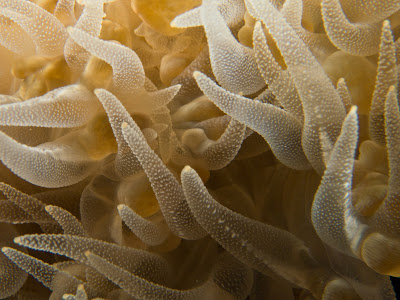After years of toying with the idea, I finally managed to attend a class at the
Inter-University Institute for Marine Sciences (IUI) in Eilat. More precisely, Alon and Ayelet managed to drag me with them to the class. Since neither Ayelet nor me are students, we were given auditor status, which meant that we sat at the end of the class and tried not to interfere too much.
The IUI is located on the beach front, just south of the Coral Reef Reserve and the Underwater Observatory.
 |
| Image of IUI facilities (from the IUI website) |
View Larger Map |
| Satellite image of south Eilat region(from Google Maps) |
The IUI consists of labs, class rooms, dormitories, and a dive center (next to the pier). The dive center
has full diving club facilities, including lockers and showers (with really hot water). Since we were visitors, were told we can dive but have to bring our own tanks. So we had to rent tanks at a regular dive club and schlep them back and forth. But, I am getting ahead of myself.
The 10-day long class was "Introduction to the Ecosystem of the Red Sea". It involved frontal classes about the geology, oceanography, and chemistry of the global and local ocean system. In addition we learned about the life (algea, small animals, coral reefs, etc.) and their interactions with ocean system. The practical part of the class included few labs, tours of the underwater environment, and research projects (the last four days). Ayelet and I stayed just for the first five days (classes and labs) and Alon who was actually registered to the class stayed for the full duration and did a project on cleaning stations in the reef.
Since the course is condensed into 10 days it was very busy. Nonetheless, we tried to go diving whenever there was free time. Either during dinner breaks, or during periods where there was lab activity we could not participate in as auditors.
Diving from the IUI was a different experience. On the one hand the local beach is rather isolated, and rarely visited. On the other, this was an area with a less impressive reef (this is why it was given to experimentalists). Still, it was full of life. Moreover, some of the experiments were different artificial habitats. These were full of soft corals and marine life.
In total I managed 5 night dives and 3 day dives (Alon and Ayelet managed more). The local facilities were great for night dive, you enter immediately into the sea, and exit few meters from a hot shower. The sea was not very cold (~23C) but the air was cooler, and there was fierce wind most of the time.
This was also the first time I got a chance to dive with my new camera setup. This included an Olympus E-PL3, two lenses (14-42, 9-18), and a new underwater housing (Nauticam) that included an additional strobe and a close-up lens for macro shots.
 |
| New camera system |
This was a major upgrade from my old setup, but required non-trivial learning. The results were good, but there is room for improvement. The main difference was a "real" housing from machined aluminum rather than the cheaper plastic ones I had until now. The difference in ergonomics and responsiveness of the keys was amazing.
And now for some images.
 |
| Jellyfish with some passengers |
 |
| Christmas Tree Worm |
 |
| Spider crab on red soft coral |
 |
| Polyp |
 |
| Add caption |
 |
| Wide angle |
 |
| Wide angle |
 |
| Clown fish |
 |
| Wide angle |
 |
| Wide angle |
 |
| Wide angle |
 |
| Wide angle with trumpetfish |
 |
| A thornback trunkfish that posed for me |
 |
| The same fish |
 |
| Closeup on some coral polyps |
 |
| Closer closeup |
 |
| Sea star (detail) |
 |
| Sea lilly (detail) |

















































